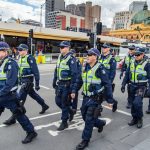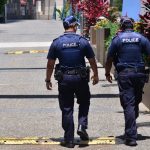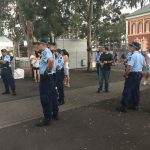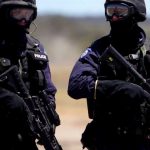NSW Police Future Crime Program: An Abuse of Power

Since February 2000, NSW police has been carrying out a secretive program to prevent future crime that targets reoffenders and individuals police merely consider to have the potential to commit crimes.
The Suspect Targeting Management Plan (STMP) was developed by the NSW police Information and Intelligence Centre in 1999. It’s managed internally, and no specific legislation has been enacted to govern its operation.
Any NSW police officer can nominate an individual as a prospect to be placed on the program. The quantitative risk assessment tools that police use to determine an individual’s risk of offending or reoffending, and whether they should be subject to the STMP, are not publicly available.
Individuals on the STMP are allocated to one of the following categories: extreme risk, high risk, medium risk or low risk. They’re unable to access the reasons why they’ve been place on the program, and nor are they able to find out how to get off it.
Once on the list, a person is then targeted by police. They’re repeatedly stopped and searched, and officers regularly visit their homes, regardless of which type of offence, if any, they have committed in the past.
Uncovering the facts
A report released last week into the use of the STMP found that the program is disproportionately targeting young Aboriginal people. The program, which has been used on children as young as 10, is damaging relationships between police and youth, while having no observable impact on crime.
The Policing Young People in NSW report was produced by the Youth Justice Coalition, a network of youth workers, lawyers, academics and policy workers.
It was written by Dr Vicki Sentas, senior lecturer at the UNSW Faculty of Law, and Camilla Pandolfini, a senior solicitor at the Public Interest Advocacy Centre.
The report is based on selected case studies provided by lawyers and NSW police data on the use of the STMP. Ms Pandolfini explained the police data obtained via the Government Information (Public Access) Act 2009 was “quite difficult to get.”
“The policy is a secret. It’s an internal policy of NSW police and it’s not publicly available,” Ms Pandolfini told Sydney Criminal Lawyers®. “That’s part of the problem. We’re unable to tell what the risk factors are that place people on the STMP.”
A discriminatory program
The researchers obtained data from five local area commands (LACs) for the financial years 2013-14 and 2014-15. And further data was also obtained from another five LACs for the financial year 2014-15.
Across the ten LACs examined over 2014-15 it was found 48.8 percent of STMP targets were under the age of 25, and 23.5 percent were children under 18 years of age. The youngest person on the program that year was 11 years old.
Looking at the racial background of STMP targets over the ten LACs for that same period, the largest single group subject to the program were Aboriginal and Torres Strait Islander people making up 44 percent of all individuals.
The data from five LACs over a two year period revealed that 54 percent of all STMP targets were Indigenous people. This is despite First Nations people only accounting for only 3.4 percent of the overall population of NSW, according to 2016 Census figures.
In 2014-15, 60 percent of people targeted by the STMP in Redfern LAC were Aboriginal, even though Aboriginal people only account for 2 percent of the population in Redfern.
Abuse of stop and search powers
The police powers to stop and search an individual without a warrant are contained in the Law Enforcement (Powers and Responsibilities) Act (LEPRA) 2002. Police can’t simply search people at random. Officers must have a suspicion on reasonable grounds for doing so.
Section 21 of the LEPRA provides that an officer may stop, search and detain a person without a warrant if he or she suspects on reasonable grounds that the individual possesses stolen property, has anything used, or intended to be used, to commit an offence, is carrying a dangerous item or weapon, or is in possession of illegal drugs.
The STMP does not provide police with any further powers than those contained in the LEPRA. However, the report outlines that courts have ruled in some cases that officers have carried out searches upon young people on the STMP in an unlawful manner.
According to Ms Pandolfini, in some instances police “don’t have the requisite reasonable suspicion to stop and search people,” and officers are “using the STMP to ground reasonable suspicion.” She stressed this was obviously not all the time, but it’s what young people on the STMP have said.
Case studies
“In three of our cases studies, the young people involved had been stopped and searched, and the court has found that the police didn’t have the requisite reasonable suspicion,” Ms Pandolfini continued.
One documented instance of an unwarranted search was the case of an 18-year-old stopped and searched in a park. The reasons recorded by police for the search were that the teenager was on the STMP and had placed his hands in his pockets after being stopped.
A magistrate subsequently found the search unlawful, as it was conducted without reasonable suspicion.
Another case study was of a 14-year-old boy in regional NSW. He was on the STMP, even though he had no prior charges. Police records indicate that he’d been stopped and searched 28 times. On one of these occasions he was stopped and stripped searched by six officers on the side of the road.
The officers claimed that as the boy was on the STMP, it was sufficient grounds to conduct the search. However, the court ruled that this was not a sufficient cause.
Steps need to be taken
The report makes a number of recommendations based on its findings. These include that NSW police stop using the STMP on children under 18. And children deemed to be at medium to high risk should be place on evidence-based prevention programs, such as those developed by Just Reinvest NSW.
It is also recommended that the STMP be amended so that people determined as low risk are no longer placed on the program. And those who are placed on it should be notified that they have been and provided with the reasons as to why.
NSW police should be given additional training to clarify search powers in regard to the STMP. And the policy and operational arrangements of the program should also be made publicly available.
The report found that “the unjustified secrecy around the STMP has prevented appropriate” examination of its impact on youth. However, researchers concluded “that the operation of the STMP is likely to be having damaging effects on young people,” and it warrants “further investigation and external scrutiny.”








